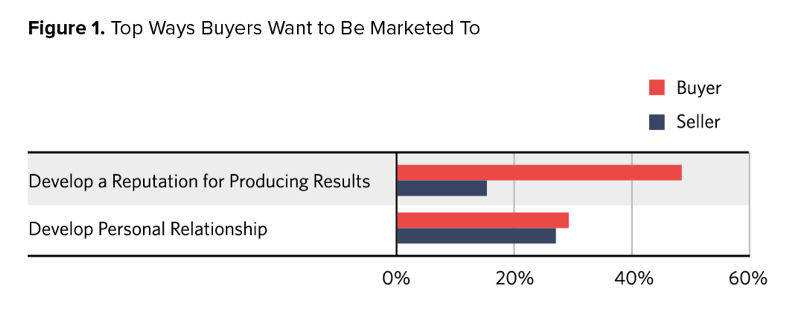Having a good reputation is key to having a successful brand, especially in the technology industry. So much so, that at Hinge, we define your brand as a combination of your reputation and your visibility. Sure, there are other ingredients in this recipe, but without a visible reputation, no one would be willing to even try your dish.
And this is more than speculation on our part. When performing research for our book Inside the Buyer’s Brain, the Hinge Research Institute asked over 1,300 buyers and sellers of professional services to identify the best ways to market to buyers:

Buyers consider a reputation for results the most important factor by a wide margin. Moreover, they ranked it about 3X higher than sellers of professional services did. No one would argue that forging a solid relationship with clients is not important, but buyers want more than that—they want results.
A powerful way of showing buyers how you’ve fared with past clients is through case stories. Case stories, sometimes called case studies, communicate your expertise, professionalism, and what you’ve accomplished.
Getting Started with Case Stories in Technology
As a technology firm, you have success stories worth sharing. Show what you can do. Here’s how to get started:
- Identify a client. Find a client with striking results or an innovative project. Your account managers and business development team will likely have great ideas about clients you’ve served well.
- Approach them. The person with the best working relationship with the client should seek their participation. Remember, this is as much their story as it is yours. They should contribute, review, and approve the case story before it’s published. A great way of encouraging their engagement is to present them with a preview of potential interview questions—these will help them decide if they want to participate.
- Gather Info. Remember: every story needs a beginning, middle, and end. Create questions for the client about the challenges they faced prior to working with you, about the solutions you provided, and about the results achieved. Get specific about those results—you improved their productivity by 20% or saved them $25,000 per year—your audience will find quantitative results more compelling than softer details.
- For deeper insights, put on your journalist hat and interview the client. Sure, a questionnaire will get some details, but there’s no substitute for a meaningful discussion. Ask follow up questions as appropriate to uncover more about the client and your contributions to their success. Record the interview (with the client’s permission) and replay it as you write.
Case Story Best Practices
As for the actual writing, here are some best practices to keep in mind:
- Keep the length in the Goldilocks zone—not too short, not too long. About 500 words is generally sufficient to say what you need to say without reader fatigue.
- Keep that journalist hat on! Give your audience the who, what, when, where, why, and how of your case story. And don’t forget to include the beginning, middle, and end I mentioned before—present the challenge, solutions, and results.
- Use images, photos, illustrations, or graphics to support key points or illustrate the results delivered.
- Include quotes. Nothing you can say will carry nearly as much weight as direct quotes from the client. Don’t overdo them, but offer them in bite-sized chunks to emphasize important points and grant your case study more credibility.
Those are the basics, but if you’re looking for examples to guide your thought process, check out a few real life case stories presented by Hinge by clicking here.
Remember, without your reputation, your technology firm will struggle to have a meaningful presence in the marketplace. Show off what you’re capable of and how you’ve done it before. Let the good work you’ve done speak for you. To learn more about building your technology firm’s brand, check out Hinge’s research study, How Buyers Buy Technology Services.

